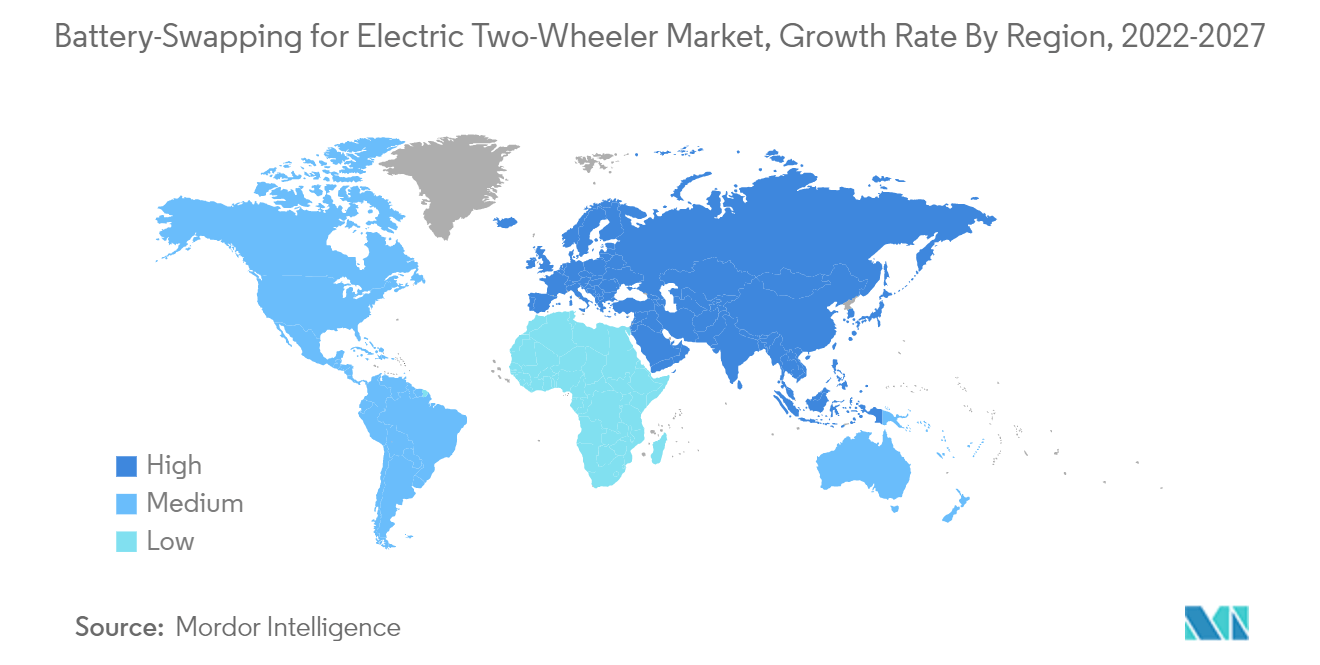Market Trends of Battery-Swapping for Electric Two-Wheeler Industry
This section covers the major market trends shaping the Battery-Swapping for Electric Two-Wheeler Market according to our research experts:
Developments in Lithium Batteries Driving the Market
Currently, the upfront cost of an electric vehicle is made up of between 40 and 70 percent of the cost of the batteries. The upfront cost may be shifted to the energy operator's network, which will then shift the cost of ownership to operations, if these batteries are decoupled and sold or rented separately. Battery swapping and interoperability can be extremely important in this since they aid in creating the supply chain network that will increase EV adoption, which will speed up the transition.
In 2021, majority of all electric two-wheeler sales in APAC, Europe, and North America were for powered by lithium-ion batteries. Additionally, Li-ion batteries will power practically all of the two-wheelers sold worldwide over the next five years. In significant markets like China and India, governmental backing for Li-ion battery-powered low-speed electric vehicles is also anticipated to support the expansion of this split in the ensuing years.
With advancements in battery technology, the price has decreased but there is still potential for improvement. Current electric vehicle (EV) batteries are bulky, expensive, and difficult to charge. As a result, research is being done to advance present technologies and boost EV adoption.
As a possible alternative, lithium-based solid-state batteries are projected to carry far more energy in the same volume and charge much faster than traditional Li-ion batteries. Instead of the liquid electrolytes used in conventional batteries, these batteries use solid-state electrolytes like ceramics or solid polymers. Smaller batteries with higher energy densities, longer life spans, and improved safety profiles may result from the application of this technology.
Key players are investing extensively on new technologies and are partnering other players in the market for advanced products. For instance,
- In January 2022, In order to jointly develop a sustainable new energy ecosystem, Hon Hai Technology Group (Foxconn), the Indonesian Ministry of Investment/Investment Coordinating Board (BKPM), PT. Industri Baterai Indonesia (IBC), PT. Indika Energy Tbk. (Indika), and Gogoro Taiwan Limited signed a Memorandum of Understanding (MoU). Under the terms of this MoU, Hon Hai, Gogoro, IBC, and Indika will look into a variety of investment opportunities and work together to establish a new energy ecosystem in Indonesia. As part of the collaboration, industries for energy storage systems (ESS), battery exchange facilities, and battery recycling will be developed. The initial focus will be on developing Indonesia's New Energy and Full Battery Platform, which will produce premium LFP or Nickel (solid state) EV batteries.
However, lithium ion batteries continue to be expensive and in short supply. The widely used but expensive lithium ion variety is already being replaced by alternatives developed from more readily accessible materials by policymakers. However, there is currently enough to meet demand for two and three-wheelers.

Asia-Pacific Dominates the Market
The electric vehicle (EV) battery swapping market within the Asia-Pacific is moving from the nascent to the expansion phase. Range anxiety, and lengthy charging process are cited as among the most barriers hindering the broader adoption of EVs. Battery swapping offers a quicker solution to handle range anxiety, where each swap takes but 10 minutes and requires much smaller space to put in compared to charging stations. Offering Battery as a Service is another solution gaining traction within the region's EV industry, given its impact on reducing the high upfront price of EVs by separating battery ownership, and hence, cost. rather than owning the batteries, customers can subscribe battery swapping plans to fulfill their unique needs.
According to data, the sales volume of electrical two-wheelers in China in 2021 reached 53.375 million units, up 16.5% year on year, and therefore the sales volume of lithium two-wheelers reached 9.287 million units, up 22.6% year on year, with a penetration rate of 17.4%.
In 2021, the expansion rate of other two-wheelers and battery swapping market is fast, thus driving the general market growth, but the expansion rate of lithium two-wheelers in 2021 is not as expected, mainly due to the price decline of lithium batteries and weakening the competitive advantage of lead-acid batteries enabled growing shared bike market, which contributed to the main increment of lithium electric two-wheelers in the country .
On the other hand, India has been actively pursuing battery swapping across the country and has been testing the viability of the swappable batteries. An important announcement was made in this year's budget regarding the adoption of a battery swap policy and the creation of interoperability standards to promote the electric vehicle (EV) ecosystem in India. Degree.
In April 2022, Niti Aayog released the draft Battery Swap Policy. Such supportive signals for the growth of the battery swap ecosystem are commendable. Until now, the focus at the national level has been mainly on creating a large network of electric vehicle charging stations, with limited emphasis on developing battery swapping infrastructure. The emergence and successful piloting of battery swapping solutions provides an opportunity to facilitate a solution-independence environment, providing a level playing field for different potential solutions in the market. and ensure a list of options for electric vehicle users.
Similarly Europe is expected to follow Asia-Pacific region in adopting battery swapping on the back of growing usage of electric two wheelers for cargo, logistics and delivery activities owing to the increased logistics and e-commerce companies across the region.


